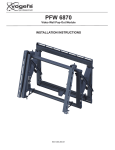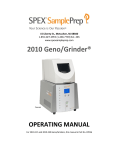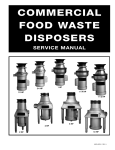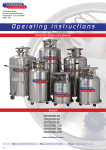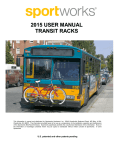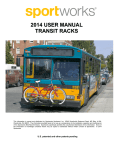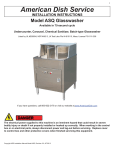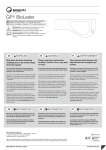Download Allied Telesis Freezer 6870 User's Manual
Transcript
15 Liberty St., Metuchen NJ 08840 1-800-LAB-SPEX (1-800-522-7739) ext 465 6870 ® FREEZER/MILL OPERATING MANUAL This manual is part number 85018 TABLE OF CONTENTS DESCRIPTION SECTION PAGE 1.0 Introduction..................................................................................................................................3 2.0 Specifications...............................................................................................................................4 3.0 Unpacking ....................................................................................................................................5 4.0 Setting Up ....................................................................................................................................6 5.0 Touch Screen Displays................................................................................................................9 6.0 Practical Operation ....................................................................................................................14 6.1 Adding Liquid Nitrogen Coolant…………………………………………………….14 6.2 Loading Samples into Freezer/Mill Vials……………………………………………15 6.3 Removing, Opening, Emptying, and Cleaning Freezer/Mill Vials…………………..17 6.4 Checking Liquid Nitrogen Level…………………………………………………….20 6.5 6820 Auto-Fill System………………………………………………………………20 6.6 6814 AutoExtractor………………………………………………………………….21 6.7 Maintenance…………………………………………………………………………21 7.0 Warranty and Service ................................................................................................................21 8.0 Trouble-Shooting Guide............................................................................................................23 Page 2 of 25 SPEX SamplePrep LLC 9.24.07 SECTION 1.0: INTRODUCTION SPEX SamplePrep Freezer/Mills are cryogenic laboratory mills that cool samples to cryogenic temperatures, and pulverize them by magnetically shuttling a steel impactor back and forth against two stationary end plugs. Since the vial is closed, the integrity of its contents is maintained: hazardous or critical samples are easily controlled, cleanup is simplified, and crosssample contamination is eliminated. Because the vial is immersed in liquid nitrogen throughout the grinding cycle, the sample is kept at cryogenic temperatures and its key aspects preserved. These features have made SPEX SamplePrep Freezer/Mills the most effective cryogenic mills in the world. They are the “mills of last resort” for many normally ungrindable samples, or samples whose composition or structure is altered by the heat generated by conventional grinding. Before operating the 6870 Freezer/Mill, familiarize yourself with these instructions. The Freezer/Mill is different in its principles and operation from any other laboratory mill. If you’re familiar with the mill and want to proceed directly to grinding, Section 6.0 (PRACTICAL OPERATION) on p.14 can serve as a general review of the actual operation of the mill. We suggest unpacking the mill, then going over its various features with these instructions in hand before attempting to add liquid nitrogen or grind a sample. OPERATING CONDITIONS: Do not set up the 6870 Freezer/Mill in an insulated or confined space. The Freezer/Mill should be run on an open countertop, in ambient air. If the entire mill is chilled during operation, components like the gas cylinders can fail. This damage is not covered by the Freezer/Mill warranty. VERY IMPORTANT: Liquid nitrogen not only makes samples brittle through severe chilling, making them “grindable,” but also cools the magnetic coil which powers the 6870 Freezer/Mill. If the mill is operated without liquid nitrogen for a period of about one minute, the coil will become very hot and may sustain permanent damage. The 6870 Freezer/Mill has a liquid nitrogen sensor that should shut down the mill when the liquid nitrogen gets too low to cool the coil. Nevertheless the nitrogen level should be visually checked during extended runs as well as topped off before every run. The Freezer/Mill warranty does not cover damage to the coil caused by operating the mill with little or no liquid nitrogen. SAFETY NOTES: 1) Liquid Nitrogen can be hazardous. Its boiling point is -195.8o C. When working with liquid nitrogen directly or indirectly, you must wear cryogenic gloves to protect your hands. Be careful not to splash liquid nitrogen on clothes or unprotected skin. Always use cryogenic gloves when handling very cold objects or materials: sample vials, the nitrogen tank valve or hose, chilled Freezer/Mill components, etc. We also recommend safety goggles to protect your eyes. 2) Do not attempt to operate the 6870 Freezer/Mill without liquid nitrogen Page 3 of 25 SPEX SamplePrep LLC 9.24.07 SECTION 2.0: 6870 FREEZER/MILL SPECIFICATIONS Type of mill: cryogenic impact mill Grinding mechanism: steel impactor driven by dual electromagnets Coolant: liquid nitrogen Weight (empty, without vial or coolant): approx. 44 lbs. (20 Kg) Grinding Vials: one 6801 Large Vial, one Mid-Size Vial (6871, 6881, 6885), or one 6753 Microvial set, also one to four Small Vials (6751, 6751/52, 6761, 6771). Typical Sample Capacity: Small Vials: actual volume with impactor, approx. 25 ml. Typical sample weights: 2 grams for biological samples, 1 gram for polymers. Effective capacity for a given sample is determined by trials. Overfilling a vial greatly reduces its efficiency. 6753 Microvial Set: 100 - 500 mg per individual 6753V Microvial, depending on sample. Mid-Size Vials have up to 5 times the sample capacity of Small Vials, and Large Vials about twice the sample capacity of Mid-Size Vials. Actual performance of any vial/sample combination depends on sample properties, cooling time, grinding time, desired outcome, etc. Typical liquid nitrogen consumption: 10-15 liters for initial cool-down and filling of the tub. 4-6 liters for each hour of operation Actual LN consumption can vary. Electrical specifications: CE Approved, available in 115V 60HZ or 230V 50HZ. Cord: 115V 60HZ version, 3-prong grounded plug supplied. 230V 50HZ version, 2-prong European plug supplied. Operator is responsible for supplying alternate line cord/plug if required. Fuses: Two 5-amp slow-blow fuses in AC Input module. 25-amp slow-blow fuse on driver board Dimensions: 20½ in. (52 cm) x 21½ in. (55 cm) x 18 in. (46 cm) CE Compliance and Certification: The 6870 Freezer/Mill has been tested for compliance with CE Directives for Industrial, Scientific, and Medical Equipment Emission, and Generic Light Industrial Immunity. Safety Features: Lid Interlock prevents mill from running if lid is not latched shut. Liquid nitrogen sensor shuts down mill if liquid nitrogen level is too low. NOTE: Liquid nitrogen level should be visually checked during extended runs as well as before every run. The Freezer/Mill warranty does not cover damage to the coil caused by operating the mill with little or no liquid nitrogen. Page 4 of 25 SPEX SamplePrep LLC 9.24.07 SECTION 3.0: UNPACKING Inspect the exterior of the packing box and report any visible damage to the carrier. Remove all packing documents from the exterior of the box, and save them for your records. Open the top of the shipping box. Remove the packing material and accessories, and gently remove the Freezer/Mill. Visually check the mill for any damage that may have occurred during shipping. Unlatch the lid and inspect the interior of the tub, ensuring that it is free of any packing material. Check the packing list to see that there are no parts missing, and inspect the accessories. If everything seems to be in proper order, we recommend you store the packaging materials, in case there you ever need to return the unit for warranty service or repair. Grinding vials must be purchased separately and are available in three sizes: large, mid-size, and small. Each new 6870 Freezer/Mill includes an Acccessory Package to match your choice of vials, either the 6870L for large vials or the 6870S for small vials. Both include an extractor for removing end plugs from cold vials, and a vial rack; the 6870S also includes an adapter for running up to four vials in the 6870. A 6870M Accessory Package is available for mid-size vials, but must be used in conjunction with the 6870L. The full range of grinding vials and accessories for the 6870 Freezer/Mill is described in our catalog (Handbook of Sample Preparation and Handling) and on our website (www.spexcsp.com). 6870 FREEZER/MILL, FRONT VIEW Page 5 of 25 SPEX SamplePrep LLC 9.24.07 6870 FREEZER/MILL, BACK VIEW SECTION 4: SETTING UP The 6870 Freezer/Mill weighs 44 pounds (20 Kg) empty. The lid opens from the front and the lid latch is in the center. The AC Input module is on the back of the cabinet, and includes the power switch and fuse tray. The fuse tray can be opened with small screwdriver or knife-blade. Also on the back of the cabinet is the vent from the liquid nitrogen tub. There are gas cylinders on both sides of the cabinet to control the movement of the lid. The control panel is on top of the lid, and can be detached for remote operation. It is connected to the lid by an RJ45 (“Ethernet”) cord. On the back of the lid is a USB port to let you link the 6870 Freezer/Mill to a PC or LIMS system. 4.1 Electrical Hookup Plug the electrical cord into the inlet on the back of the Freezer/Mill cabinet, and then into a standard 3-prong grounded electrical outlet. We recommend a fused 20-amp circuit for the 115V/60 HZ version. If you have the 230V/50HZ version of the mill, make sure the cord and plug conform to local electrical codes; we furnish the 230V/50HZ 6750 Freezer/Mill with a standard European 2-prong plug with cord. 4.2 Power Switch and Control Panel Electric power to the Freezer/Mill is controlled by the rocker switch on the inlet module. It is marked with two numerical symbols, zero (0) for “off” and one (I) for “on.” Press the one (I) side of the switch to turn the power on, or press the zero (0) side of the switch to turn the power off. When power to the mill is on, the control panel display will light up. Page 6 of 25 SPEX SamplePrep LLC 9.24.07 The control panel is a touch-screen, activated by a stylus. The Freezer/Mill is programmed and operated through this control panel, whose successive screens are described and illustrated in Section 5, starting on page 8. Programmable parameters include pre-cooling time, grinding time, cooling time between grinding periods, the number of grinding periods, and the rate of grinding. The control display also warns if the lid is not fully closed, or if there is not enough liquid nitrogen in the tub. 4.3 Lid and Lid Latch, Coil Assembly and Coil Gate, LN Sensor The lid of the 6870 Freezer/Mill supports the coil (dual electromagnet assembly) and coil housing. To open the lid, hold the lid down with one hand, and with the other pull the upper end of the latch toward you. The lower end of the latch should disengage from the cabinet. Release the lid and it should be pushed up by the gas cylinders, which also keep the lid raised when open. The lid must be open to put vials in the coil and take them out. Liquid nitrogen (LN) is added with the lid open, unless the 6870 is equipped with the 6820 Auto-Fill System. The lid must be shut and latched for the Freezer/Mill to run. Push the lid down, hold it down while engaging the latch, then lock the latch by pushing its top end toward the cabinet. The circular hole on the right side of the coil housing is where to insert a vial for grinding. The coil gate keeps the vial or vials in place during grinding, but must be lowered to insert or remove vials. The rectangular space toward the top of the coil housing is for pre-cooling loaded vials. (Do not run the 6870 Freezer/Mill without a loaded vial in the coil.) The coil gate holds the vial or vials in the coil during grinding. To lock a vial in place, loosen (unscrew) the coil gate handle a turn or two, and position it so the handle passes through the slot in the coil gate when the gate is raised. Tighten the coil gate handle against the gate, so the gate contacts the vial snugly, but do not overtighten the gate as this can crack the plastic center section of the vial. When the coil gate handle is properly tightened, fold it down to lock the gate during grinding. Always use the proper Adapters for Mid-Size and Small vials (see 4.4), and always wear gloves when touching a chilled vial or any part of the chilled coil housing! The LN sensor is behind a shield on the back wall of the LN tub. If there is not enough liquid nitrogen in the tub to start the mill, when RUN is touched the STATUS screen (p. 10) will display STATUS: LOW LN LEVEL. If the LN runs low during a grinding program the same message will appear and the program will stop. To continue running, fill the tub with liquid nitrogen to the mark. When RUN is pressed, the grinding program will start over. To keep a run from being interrupted by the liquid nitrogen (LN) sensor, the LN level should be visually checked from time to time during extended runs, as well as before every run. The 6870 Freezer/Mill can run low on LN during extended runs, so should be checked after each 30 minutes of grinding time, and the LN topped off if necessary. The Freezer/Mill warranty does not cover damage to the coil caused by operating the mill with little or no liquid nitrogen. Page 7 of 25 SPEX SamplePrep LLC 9.24.07 4.4 Grinding Vial Sizes, Adapters, and Vial Openers. Large vials (6801, 6871) are run one at a time in the 6870 Freezer/Mill, without any adapter. Large vials are opened by the 6804 Extractor/Vial Opener, which is part of the 6870L Accessory Package. Mid-Size vials (6881, 6883, 6885) are run one at a time, but the 6886 Mid-Size Adapter must be placed in the coil first, to center and align any Mid-Size vial. Mid-Size vials can be opened by the 6804 Extractor/Vial Opener, but only by installing the 6884 Mid-Size Vial Adapter for the 6804. The 6884 and 6886 Adapters comprise the 6870M Accessory Package. Most Small vials (6751, 6761, 6771) can be run one, two, three, or four at a time in the 6870 Freezer/Mill. However, they must be used in conjunction with the 6806 Multi-Vial Adapter, an X-shaped insert for the coil. The 6806 Adapter keeps the vials parallel to each other and the coil, so each impactor moves back and forth in line with the magnetic field. Also, if a small vial were to be positioned diagonally inside the coil, the gate could not be properly tightened against the vial, and an end plug might work its way out of the vial during grinding. When running Small vials, make sure the coil gate contacts the end plug of every vial. If the gate needs adjustment to do this, the bottom or pivot end of the gate can be moved toward or away from the coil housing by turning the gate clockwise or counterclockwise on its mounting bolt. Unlike other Small vials, the 6753 Microvial Set is run one at a time with the 6806 Adapter. Each 6753 set includes three 6753V Microvials. If more than one 6753 Microvial Set is placed in a 6870 Freezer/Mill, some of the individual Microvials will be shielded from the magnetic field, and grinding in those vials can be ineffective. Page 8 of 25 SPEX SamplePrep LLC 9.24.07 SECTION 5.0: TOUCHSCREEN DISPLAYS The 6870 Freezer/Mill is programmed and operated through a series of touchscreen displays. Transition between screens, and all programming and operating commands, are done by touching the screen with a stylus. Do not use a sharp point as this can damage or deface the screen. 5.1 LOGO SCREEN When you switch on the power, the LOGO screen appears first. This says “SPEX SamplePrep 6870 Freezer/Mill” and includes a graphic representation of the Freezer/Mill mascot. Touch the LOGO screen anywhere to transfer to the CURRENT SETTINGS screen. 5.2 CURRENT SETTINGS SCREEN This screen displays whatever program is currently set up to run. Here is a typical program, as displayed: CYCLES 3 PRECOOL 10 MIN RUN TIME 2 MIN COOL TIME 2 MIN RATE 10 CPS SETTINGS Start SCRN CURRENT SETTINGS SCREEN If the Freezer/Mill has a loaded vial in the coil, is filled with LN, and the lid is down and latched, this is what happens when the mill is started with these settings: 1) Precool: the coil is inactive while the vial cools under LN for 10 minutes. 2) First cycle: the coil is activated and the impactor grinds for 2 minutes at a rate of 10 cycles per second (20 impacts per second). 3) Cool time: the coil is inactive for 2 minutes while it and the sample cool back down. 4) Second cycle: the coil is activated and the sample is ground for another 2 minutes. 5) Cool time: the coil is inactive for 2 minutes. Page 9 of 25 SPEX SamplePrep LLC 9.24.07 6) Third cycle: the coil is activated for the final 2-minute cycle. When it is done, the program is over and the sample has been ground for a total of 6 minutes. 5.3 STATUS SCREEN To run the program displayed on the CURRENT SETTINGS screen, touch “Start SCRN.” This transfers you to the STATUS screen, which allows you to start the mill, stop it, or pause in the middle of a grinding program. (To change the settings, touch RTN on the STATUS screen to go to the CURRENT SETTINGS screen. Touch SETTINGS to go to the SETTINGS screen, and see Section 5.4 for instructions.) In the STATUS screen, the STATUS line displays the stage of the program: in a typical program, the sequence is STATUS: PRECOOL, STATUS: GRINDING, STATUS: COOL DOWN, STATUS: GRINDING, etc., to the end of the program, which is displayed as STATUS: RUN COMPLETE. Before a run this screen displays STATUS: STANDBY. STATUS: STANDBY Time Remaining: 0:00 Cycles Remaining: 0 RATE: 10 PAUSE ----------- I ------RUN STOP RTN STATUS SCREEN before a run To start the Freezer/Mill, press RUN. Before you do this, fill the tub with liquid nitrogen, place a loaded vial in the coil, and latch down the lid. If there is not enough liquid nitrogen (LN) in the mill, the STATUS line of the STATUS screen will display STATUS: LOW LN LEVEL. If the lid is not down and latched, the STATUS line will display STATUS: LID UP. If the mill is filled with LN, and the lid is latched down, the STATUS line will initially display STATUS: INITIALIZING, then STATUS: PRECOOL. That marks the beginning of the grinding program. Page 10 of 25 SPEX SamplePrep LLC 9.24.07 During the PRECOOL stage the TIME REMAINING line counts down the time for that stage in 5-second increments: 4:45, 4:40, 4:35, etc. After the PRECOOL stage comes the first GRINDING stage, and the screen displays STATUS: GRINDING. The TIME REMAINING line will display the time left in that grinding stage. If there are 3 grinding periods, during the first one the CYCLES REMAINING line will display 3 OF 3, during the second the CYCLES REMAINING line will display 2 of 3, etc. In every stage the TIME REMAINING line will count down the time left in that stage in 5-second increments. For example, if you were running the program on the CURRENT SETTINGS screen displayed on page 8, and you were 15 seconds into the second grinding period, this is what the STATUS screen would display: STATUS: GRINDING Time Remaining: 1:45 Cycles Remaining: 2 RATE: 10 PAUSE ----------- I ------RUN STOP RTN STATUS SCREEN during a run Between any two grinding periods is the COOL DOWN stage, displayed as STATUS: COOL DOWN. When the grinding program is complete, the START screen will display STATUS: RUN COMPLETE, TIME REMAINING: 0:00, and (in the case of the program displayed on page 8) CYCLES REMAINING: 0 OF 3. While in the STATUS screen, the only parameter you can change is the RATE. It is changed by touching the slider (I) and moving it to the left or right. Moving the slider to the left decreases the rate. Moving it to the right increases the rate. As the rate changes, the number in the display will change. Rate is the number of back-and-forth cycles per second of the impactor. Since the Page 11 of 25 SPEX SamplePrep LLC 9.24.07 impactor strikes both ends of the vial, a rate of 10 represents 20 impacts per second. The factory default setting for the rate is 10, and any saved program will revert to a rate of 10. To stop a program, touch STOP. The program will end. If RUN is pressed the entire program will start over. To pause during a grinding program, touch PAUSE. The STATUS screen will hold the settings at that moment (elapsed time, cycle, etc.), and the PAUSE “key” will darken. To resume the program, touch PAUSE again. When PAUSE is darkened, touching START will not re-start the program, but the screen will read STATUS: INITIALIZING. This state will persist until you touch PAUSE, which will resume the program at the point where you first touched PAUSE, or touch STOP, which will end the program. To change parameters (Precool time, grinding time, cool down time, cycles), touch RTN (return) to go back to the CURRENT SETTINGS screen, and then touch SETTINGS to go to the SETTINGS screen. 5.4 SETTINGS SCREEN To store a program, begin in the SETTINGS screen. This is how it appears with the program from the CURRENT SETTINGS screen as seen in Section 5.3 CYCLES: 3 ------I--------------- PRE: 10 Min --------I------------- RUN: 2 Min -----I---------------- COOL: 1 Min --I------------------- RATE: 10 CPS -----------I---------- RETURN STO/RCL SETTINGS SCREEN To change any setting, touch the appropriate slider (I) and move it. Moving the slider to the left decreases the setting. Moving it to the right increases the setting. The number of the changed setting will appear in the left-hand column, also in the CURRENT SETTINGS screen. To run a program with the new settings, touch RETURN to return to the CURRENT SETTINGS screen. Then touch START SCRN to go to the STATUS screen, and touch RUN. Page 12 of 25 SPEX SamplePrep LLC 9.24.07 To store the new program on the CURRENT SETTINGS screen, or to recall a stored program to override the new program, touch STO/RCL to take you to the first of two STORE/RECALL screens: 5.5 STORE/RECALL SCREENS Rcl Sto PRESET O: FISH SCALES Lbl Rcl Sto PRESET 1: Lbl Rcl Sto PRESET 2: Lbl Rcl Sto PRESET 3: Lbl Rcl Sto PRESET 4: Lbl RETURN MORE FIRST STORE/RECALL SCREEN In this version of the screen, only Preset Program 0 has been stored and named. Touching MORE sends you to the second STORE/RECALL screen, which differs from the first only in being numbered for programs 5 to 9. To return from the second STORE/RECALL screen to the first, touch RETURN. 5.51 Storing a new program To store the program now in the SETTINGS screen as Preset Program 2, touch Sto to the left of PRESET 2. To name this program, touch Lbl. This will transfer you to the KEYBOARD screen, a simplified version of the standard keyboard on a computer or typewriter. In addition to number and letter keys, this keyboard has two symbol keys (#, %) and six function keys (SHIFT, SPACE, BACK, CLEAR, ENTER, AND CANCEL). Page 13 of 25 SPEX SamplePrep LLC 9.24.07 As you touch the letter/number keys, what you have entered appears above the keyboard in a mini-screen with a centered cursor. The SHIFT key lets you shift back and forth from upper case to lower case. Touching the SPACE key advances the cursor one space. Touching the BACK key sends the cursor back one space. The CLEAR key clears whatever you have entered on the mini-screen. The ENTER key enters whatever appears in the mini-screen in the STORE/RECALL screen, as the name of the program where you touched Sto. The CANCEL key does not change anything on the screen, but returns you to the STORE/RECALL screen. To run the program you have just entered, touch RETURN to go back to the SETTINGS screen. Review the settings, touch RETURN to go back to the CURRENT SETTINGS screen, touch START/SCRN to go to the STATUS screen, and then touch RUN. 5.52 Recalling a program In the STORE/RECALL screen, touch Rcl next to the preset program you want to recall. Touch RETURN to see the settings for that program displayed in the SETTINGS screen. To run the recalled program, touch RETURN to go to the CURRENT SETTINGS screen. Touch START/SCRN to go to the STATUS screen, and then touch RUN. SECTION 6.0: PRACTICAL OPERATION 6.1 Adding Liquid Nitrogen Coolant. Liquid nitrogen is added to the 6870 Freezer/Mill with the lid open. There is a fill mark 1-3/4 inches (4.5 cm) below the lip of the tub. If the liquid nitrogen is above this mark when the lid is closed, LN can splash outside the tub. Always close the lid slowly to avoid splashing. Liquid nitrogen will most likely to be available either in a large tank with a flexible steel hose, or in smaller Dewar flasks. The 6870 Freezer/Mill typically consumes 5 to 8 liters of LN during initial cool-down, and another 2 to 5 liters per hour, depending on use. Unlatch the lid and the gas cylinders will push it open. To unlock the latch, press down on the lid and pull the top of the latch toward you and down. Disengage the bottom of the latch and the lid can be opened. The coil mechanism is attached to the lid and will rise with it. The coil gate is on the right side of the coil housing. To lower the coil gate to insert a loaded vial or vials for grinding, align the coil gate handle with the slot in the coil gate, and pull the coil gate to the right. Page 14 of 25 SPEX SamplePrep LLC 9.24.07 Note that there are three different sizes of vial that can be run in the 6870 Freezer/Mill: Large, Mid-Size, and Small. Mid-Size vials must be run with a 6886 Adapter in the coil, and Small vials must be run with a 6806 Adapter in the coil. Large vials do not need an Adapter. See Section 4.4 for details. With the vial or vials (and adapter) in place, loosen the coil gate handle a turn or two counterclockwise, align the handle with the slot, close the gate, and turn the handle clockwise until the gate is in snug contact with the vial or vials. To lock the gate, fold down the gate handle against the gate. Do not overtighten the gate, as this can crack the vial’s center section. If the Freezer/Mill tub is empty, pour liquid nitrogen (LN) into the tub about a third of the way. Initially LN will boil off vigorously, but as the tub cools the boiling will subside. Add more LN gradually, to avoid splashing and boiling over. When the LN is up to the fill mark and boiling is subdued, push the lid down gently until the bottom of the latch can be engaged; the lid is still not locked down. Pause if splashing becomes excessive. When the vapor stream has subsided, open the lid again and top off the liquid nitrogen in the tub, filling it to the mark on the inside wall of the tub. If you have not already done so, insert a loaded vial or vials in the coil, and tighten and lock the coil gate. One or two additional vials can also be put in the precooling chamber above the coil at this time. Shut the Freezer/Mill’s lid, engage the latch as before, and lock the lid shut by pushing the top of the latch toward the lid. When the lid is closed and latched, further nitrogen boiling will be visible as a stream of condensed water vapor (“fog”) from the vent in the rear of the Freezer/Mill; this is normal. A grinding program can now be run, as outlined in Section 5.3, Status Screen. 6.2 Loading Samples into Freezer/Mill Vials 6.21 Introduction and General Recommendations Pick a sample typical of those you will be grinding. As a rule of thumb, the sample should be in pieces small enough to circulate inside the vial as the impactor moves back and forth, and should take up no more than half the volume of the vial, with the impactor in the vial. These are typical sample sizes for the different sizes of Freezer/Mill vials: Sample Large Vial Mid-Size Vial Small Vial Microvial Plant Tissue, 20-40 g Bone, Muscle, etc. 5-20 g 2-5 g 100-300 mg Polymer pellet. 2-10 g 1-2 g 50-100 mg 10-20 g In practice, the optimum parameters (sample weight and size, pre-cooling time, grinding times and number of cycles, impactor rate, etc.) are customized to match particular samples. Your own Page 15 of 25 SPEX SamplePrep LLC 9.24.07 procedure for your own materials should be determined by trials; in practice almost no two materials grind alike. Avoid overfilling vials as this greatly reduces grinding efficiency. If at first the sample doesn’t grind as intended, try these strategies: • Reduce the overall weight of the sample. (Some fibers and thin films may grind best in the Small vial with a sample weight of 100-200 mg.) • Reduce the size of the individual pieces to ¼ or 1/8 inch (6 to 3 mm). • Increase the precooling time. (20 minutes of precooling is about the maximum necessary for most samples to reach LN temperatures.) • Grind longer. (30 minutes of actual grinding time is the maximum recommended for one run, due to the LN capacity of the tub, but you can top off the LN and repeat the run if necessary.) When handling chilled samples or vials, or touching parts of the Freezer/Mill that have been chilled by LN, always wear protective gloves. 6.22 Size of Sample Pieces The size of sample pieces is important. For uniform results in Small vials we recommend most samples be cut into pieces smaller than ¼ inch (6 mm). Very tough samples such as fresh bone should be cut smaller, down to 1/8 inch (3 mm). Samples can be cut proportionately larger for Mid-Size and Large Vials. In any case the size of the pieces should be controlled, and consistent from sample to sample. There are several reasons for this: • The more irregular the size of the sample pieces, the more difficult it is to predict the results. Uniform procedures work better with uniform samples. • Thin fibers and films in particular can very difficult to cryogrind unless they are cut into small pieces first. Wads of long fibers and crumpled balls of film take up extra room and can be elastic, even at LN temperatures. • Tough samples in large pieces can be very difficult to grind, and in rare cases may damage the vial. A large, wedge-shaped piece of bone or a tough polymer can act as a wedge to push a moving impactor through the side of the polycarbonate tube. 6.23 Putting a Sample into the Vial at Room Temperature Most Freezer/Mill samples do not have to be kept cold all the time, and can be loaded at room temperature. To load a vial, first assemble it halfway by pushing an end-plug into a center cylinder. Add the sample and impactor to the vial, and close it with the other end-plug. Shake the vial to make sure the impactor has room to move back and forth. 6.24 Putting a Cold Sample into the Vial and Keeping it Cold Some samples must be kept cold, such as plant or animal tissue being prepared for RNA extraction. When a sample is cold, and must be kept cold throughout the grinding process, the loading procedure is more elaborate. Assemble a center cylinder and end-plug, as in 6.23, then chill the end-plug and about an inch of the cylinder in a shallow liquid nitrogen bath. The vial racks with the 6870L and 6870S Page 16 of 25 SPEX SamplePrep LLC 9.24.07 Accessory Packs can be placed in an insulated container to hold the vials upright during chilling. At the same time, chill an impactor separately. As soon as the submerged end of the vial is chilled, drop in the cold sample and then the chilled impactor. (Always wear insulated gloves when handling chilled vial components directly!) Now carefully insert the other end-plug, still warm, into the warm end of the cylinder. The vial can now be carefully placed in the mill, or submerged in a liquid nitrogen bath outside the mill, as long as you are careful not to let the sample touch the warm end plug before it has cooled down. Very important: never force an end plug (warm or cold) into a cold polycarbonate cylinder. Polycarbonate shrinks when chilled, and can crack if stressed. When you follow this procedure for loading cold samples, if the cylinder has cooled to the point where the end-plug fit is too tight, warm the end of the cylinder before inserting the end-plug. 6.25 Putting a Very Small Sample in the Vial and Keeping it Cold A variant of the loading technique in 6.24 can be used to grind very small samples with the open pre-chilled vial upright. Place the sample on the chilled end-plug and add a small amount of fluid such as an extraction medium or water. The frozen fluid will bulk up the sample enough so it will circulate in the vial during grinding. To speed up this process with Small-sized vials like the 6751, some users first prepare small “ice cubes” of the sample frozen together with 0.5 ml to 1 ml of fluid. 6.26 Placing Vials in the Freezer/Mill Coil Before placing a vial or vials in the 6870 Freezer/Mill, put on cryogenic gloves. Unlatch and lift the lid of the mill, and open the coil gate. If you are running Small or Mid-Size vials make sure the proper Adapter is in the coil. Pick up the vial(s) with your gloved hand or an Extractor/Vial Opener and insert the vial(s) in the coil. Close the coil gate and tighten it against the vials(s) by turning the gate handle clockwise, but do not overtighten the gate. Lock the gate by folding down the handle. If you have additional vials you wish to pre-cool, pick them up the same way and insert them in the pre-cooling compartment of the coil housing. Check the liquid nitrogen (LN) level and top it off if necessary. Gently close the Freezer/Mill lid, and latch it. Latch the lid shut. You are now ready to run a grinding program, as described in Section 5. 6.3 Removing, Opening, Emptying, and Cleaning Freezer/Mill Vials 6.31 Removing Vials from the Freezer/Mill At the conclusion of the grinding cycle, unlatch the lid and let the gas cylinders lift it. Do not force the lid, but allow it to rise at its own speed. If the gas cylinders are too worn or chilled to lift the lid, lift the lid gently. Remove the vial or vials from the coil, using gloves or an Extractor/Vial Opener. At this point you may want to shut the lid to conserve LN or insert another vial and begin another grinding cycle. Page 17 of 25 SPEX SamplePrep LLC 9.24.07 6.32 Opening the Vials To open a vial, slip the open end of the appropriate Extractor/Vial Opener over a threaded endplug, align the pegs in the end-plug with the slots in the Extractor, and turn the knob clockwise until the end-plug is drawn out. If the end-plug is drawn out within a millimeter or two of the end of the center cylinder and stops, rock the Extractor gently to dislodge the end plug. Always be careful that the vial does not fall and spill its contents. If the Extractor/Vial Opener jams with the end-plug part way out, let the vial warm up before removing the end plug. Forcing out the end-plug can damage the Extractor or break the polycarbonate center section. The best way to prevent the Extractor from jamming is to make sure both the Extractor and the threaded end-plugs are dry and clean before you use them. If the Extractor/Vial Opener jams when being threaded into a cold end plug, this is probably due to water condensing on the extractor screw. The water freezes when it contacts a cold end plug. If this happens, make a habit of wiping off the screw with a paper towel before each use. Note that the end of the screw is tooled with an “X” cut to help remove any ice that forms on the end plug, but this is not always effective. Chilled vials can also be opened easily and quickly with the 6814 Auto-Extractor (page 22), an optional motorized accessory for opening Small and Large Freezer/Mill vials. Rarely an end plug will stick in the vial when cold, even if the Extractor screw and end plug threads are dry and clean. If this happens do not force the end plug out, as you may damage the vial and/or the Extractor. First warm up the vial. The vial can be allowed to warm up gradually, wrapped in several layers of cloth or paper towels, or a hair-dryer or running hot water can be used to warm up the stuck end-plug more rapidly. Once the vial is warm, the stuck end plug can be drawn out by hand or with a pair of pliers. When using pliers to extract an end-plug, rotate the end-plug and pull gently, as if you were trying to unscrew a bottle-cap. Forcibly rocking the end-plug from side to side can stress the polycarbonate tube and crack it. Caution: pressure can develop inside a Freezer/Mill vial as it is warming. This is most likely caused by some liquid nitrogen having been introduced into the vial when it was being loaded, so try to avoid this. As pressure builds, an end plug can pop out and the sample can be lost. For this reason we recommend handling vials with care when forcefully warming them, and wrapping them in toweling if they are being warmed up gradually. 6.33 Emptying the Vials As soon as an end plug is removed from a cold vial, empty the contents of the vial into a suitable container: the quicker the better as condensation on a cold sample occurs rapidly. Often it is helpful to tap the closed end of the vial to release the ground sample. Remember that the impactor may slide out ahead of the contents or with them, and that the longer the sample is exposed to air, the more water it will acquire from condensation. Samples which were tacky, squishy, etc., at room temperature will also return to that state as they warm up, and may agglomerate. Page 18 of 25 SPEX SamplePrep LLC 9.24.07 The impactor will have to be separated from the sample and can be handled with gloved fingers, a strong magnet, tongs, or pliers. Tools without a good gripping surface are likely to slip off the impactor. If some condensation on a cold sample is unacceptable, you can either wait for the sample vial to warm up before opening and emptying it, or open and empty a chilled vial in a glove box filled with dry nitrogen gas, argon, etc. Small amounts of sample usually adhere to the vial’s impactor, end plugs, and plastic cylinder. Brushing or scraping these surfaces of the vial can often recover this fraction of the sample. Again, speed is important to minimize condensation and other effects of warming. If it is necessary to recover 100% of the sample, let the vial warm up and add some water or other liquid that will not affect the polycarbonate (see 6.34, Cleaning the vial). Shake the vial, empty it onto some filter paper, and rinse again if necessary to recover all the sample. 6.34 Cleaning the Vials Freezer/Mill vials may be superficially cleaned quickly and easily by placing them under running hot water. If the vial is cold a coating of ice will form on the steel parts, but will melt quickly as the water runs. The plastic center cylinders for all vials, and the Poly-Vial end plugs and impactor capsules, are made of polycarbonate. While this polymer is very tough at low temperatures, it is sensitive to alcohol, acetone, and other organic solvents, and should be cleaned only with soap and water. A mild bleach solution will control organic contamination. Polycarbonate can be autoclaved, but this will weaken it. Before re-using polycarbonate parts, always inspect them for cracks or other damage. They may last for dozens or hundreds of samples, but as soon as they begin to crack they should be discarded. If sample adheres to the steel end plugs and impactor, they can be cleaned with water and soap or detergent, or with organic solvents. If they must be disinfected or cleaned of any organic residue, they can be washed with bleach or chemical cleaners or autoclaved, but should always be dried immediately after use. The steel parts in the 6751, 6801, and 6881 vials are made from 440C Stainless Steel, a so-called magnetic stainless steel, which is corrosion-resistant but will rust if left in contact with water. Surgical-grade stainless steel, which is truly rustproof, is nonmagnetic and cannot be used for Freezer/Mill end-plugs and impactor. The steel parts of the chromium-free 6771, 6871, and 6883 vials can also be washed, disinfected, autoclaved, etc., but chromium-free steel is not rust-resistant and must always be dried immediately after washing. Store Cr-Free Vial parts in a sealed bag with a desiccant. Rust on steel Freezer/Mill parts can be removed by scrubbing them with steel wool or an abrasive cleanser. If rusting persists, store the parts in a sealed bag with a desiccant. Page 19 of 25 SPEX SamplePrep LLC 9.24.07 6.4 Checking The Liquid Nitrogen Level Every time you remove or insert a vial, note the level of liquid nitrogen (LN) in the tub. You should top off the LN when needed as a matter of routine. If your programmed grinding cycle includes more than twenty or thirty minutes of actual grinding time, you should visually check the nitrogen level at about that point and add more if needed. We do not recommend cumulative grinding time of more than thirty minutes per run, as after that much grinding the LN level is close to the point where the LN sensor will shut down the mill. However, if you must run the mill for an extended time, and the LN sensor stops the grinding program, the mill can be refilled with LN and the grinding program resumed where it stopped. The 6870 Freezer/Mill can be refilled automatically with the 6820 Auto-Fill System, which adds LN to the tub when the LN level is low. The 6820 Auto-Fill System must be installed and calibrated at our factory, so if you did not order your 6870 Freezer/Mill with an Auto-Fill System and want to order one later, the Freezer/Mill must be returned to SPEX SamplePrep LLC for installation and calibration. 6.5 6820 Auto-Fill System: Description, Installation, Operation Description: the 6820 Auto-Fill System automatically transfers liquid nitrogen (LN) to the 6870 Freezer/Mill during operation, making hand-filling unnecessary. The Auto-Fill mechanism includes a cryogenic valve linked to LN sensors in the tub. When the LN level is low, the valve opens during Pre-Cool or Re-Cool stages to let LN into the tub. The Auto-Fill System as supplied also includes a safety valve for the LN transfer hose. LN transfer hoses can vary with the LN supply tank or line, so one is not included with the 6820 Auto-Fill System. Four-foot and six-foot transfer hoses of standard design (part numbers 6906 and 6907) can be purchased from SPEX SamplePrep, or custom transfer hoses can be designed and supplied by the user. The LN inlet is a male ½ inch JIC fitting placed low on the right side of the Freezer/Mill, so the outlet of the hose requires a female CGA295 fitting. The 160 liter and 240 liter LN tanks used by many of our customers generally have a male 3/8” (9.5 mm) NPT outlet, so SPEX transfer hoses come with a matching female 3/8 in. NPT fitting. We do not recommend excessively long transfer hoses. LN tanks come in two types, high-pressure and low-pressure. Some LN tanks have valve systems to switch from low pressure to high pressure. Always use a low-pressure LN supply, with maximum pressure of about 20 psi. Installation: install the safety valve on the outlet of the tank or LN line, with the gooseneck tilted up and the valve outlet down. Then attach the LN transfer hose to the safety valve, and the other end to the inlet on the Freezer/Mill. The safety valve should be higher than the LN inlet on the Freezer/Mill. The purpose of the safety valve is to have an outlet for nitrogen vapor in case the mill and supply tank valves are both shut, and pressure builds up inside the hose. When installing the safety valve and transfer hose, use Teflon plumber’s tape on all joints, and tighten the nuts with a wrench. If the joints leak, tighten them further and/or use more tape. Page 20 of 25 SPEX SamplePrep LLC 9.24.07 Operation: when the 6870 Freezer/Mill is set up for the first run of the day, with a loaded vial in the coil, make sure the LN valve on the supply tank or line is open. Go to the STATUS screen and touch RUN. The Auto-Fill valve will open and let LN into the Freezer/Mill tub. The valve may close and open several times before the tub is full and Pre-Cool timing starts, but this is normal. LN boils and splashes as it enters the tub and this may temporarily “fool” the upper LN sensor. However, the Auto-Fill System has a built-in pause for the LN to stabilize before measuring the LN level again. Pre-cool countdown will not begin until the tub is full of LN. During a long run, if the lower LN sensor detects a low LN level, the LN valve will open during a re-cooling period. Again, the valve may open and close several times while the tub is filling, but during “Auto-Filling” the timer stops, and will not start again until the tub is full. At the end of a run the LN level in the tub may seem low, but this is only because the lower LN sensor has not triggered the Auto-Fill System to fill the tub with LN. The 6820 Auto-Fill System has been designed to work with typical grinding programs that involve a pre-cooling period and repeated short grinding and re-cooling periods. If you want to use the 6870 Freezer/Mill in a different way – for example, by having a single long period of continuous grinding – please call us first to make sure your plans and the Freezer/Mill are compatible. The lower LN sensor will not trigger the Auto-Fill System to add LN during a grinding period, just during pre-cooling before grinding, and during the re-cooling periods between grinding periods. 6.6 Optional 6814 AutoExtractor (see our catalog or website, www.spexcsp.com) The 6814 AutoExtractor is a motorized electrical accessory for quick and safe removal of endplugs from Freezer/Mill vials. It can open both Large-size and Small-size vials but cannot be adapted for Mid-Size Freezer/Mill vials or individual 6753V Microvials. Out of the box, the AutoExtractor is set up for Large vials, but it includes an easily installed insert for handling Small vials. AutoExtractor operation is a motorized version of the manual 6804 and 6754 Extractors. The end-plug of a chilled vial is placed in the bell of the extractor, with the locating pins lined up with slots in the bell. Then a rocker switch is pressed up to start the extractor screw, which winches out the end-plug. When the vial is opened, pressing the rocker switch down and reversing the screw can retrieve the end-plug. The 6814 AutoExtractor takes the “wrist work” out of opening Freezer/Mill vials and is recommended for labs with high sample throughput. 6.7 Maintenance The 6870 Freezer/Mill has been designed to provide trouble-free operation over a long period of time. To assure proper performance, perhaps the most important factor is cleanliness. When the unit is at room temperature, any spilled powders or liquids should be wiped up immediately. The internal tub should be wiped clean with a damp cotton cloth after every use. This should prevent the buildup of any powders, mold/mildew, or unsightly gunk over the life of the unit. If you have spilled any sample powder or liquid inside the unit during a sample run, wait until you are no longer going to continue using the unit, and the mill has warmed up to room Page 21 of 25 SPEX SamplePrep LLC 9.24.07 temperature before attempting to clean it. Once the unit has attained room temperature, wipe down the unit as indicated previously. After every period of use, the mill is going to be wet with condensation since the Freezer/Mill will pick up moisture as long as it is cold. To maintain the exterior of the unit, first disconnect the Freezer/Mill. Then an occasional spraying and wiping down with a mild window cleaner or similar product will be sufficient. In the rare case that you may need to service the 6870 Freezer/Mill, please call SPEX SamplePrep Customer Service for assistance. Maintaining the Grinding Vial Sets and the Extractor is described in section 6.34, “Cleaning the vial, on pages 17-18. SECTION 7.0: WARRANTY AND SERVICE If you have any questions about the OPERATION, MAINTENANCE, or SERVICE of your 6870 FREEZER/MILL, please call SPEX SamplePrep at 1-800-522-7739 or 732-549-7144, Extension 465. 7.01 Warranty SPEX SamplePrep LLC guarantees its products and new equipment against defects in materials or workmanship for two years from the date of original shipment. Repairs, replacements, or parts are guaranteed for 30 days or for the remaining original warranty period (whichever is greater) for the item that was repaired or replaced. Items not produced by SPEX SamplePrep LLC carry the manufacturer’s warranty only. The warranty generally does not cover normal wear and tear due to routine use, or equipment failure due to operator misuse or negligence. An example of the latter is running the Freezer/Mill until it is out of liquid nitrogen and the coil overheats and fails. 7.02 Product Specifications Every effort has been made to provide complete and accurate product operating information in this manual. However, since specifications are subject to change without notice, changes may be made from time to time to improve the performance of the product. Therefore slight changes that are not reflected in the current illustrations should be considered minor and inconsequential for the purposes of this operating manual. 7.03 To Arrange A Return Shipment We want you to be happy with whatever you purchase from SPEX SamplePrep. Please bring any problem to our attention, but please do not return any item before contacting us for a Return Authorization Number and instructions. Unauthorized returns will be refused. Cost for all return transportation is the responsibility of the customer. Credit for returned merchandise will be issued only after goods have been received and inspected. Returned goods are subject to a 25% restocking charge up to a maximum of $200.00. Page 22 of 25 SPEX SamplePrep LLC 9.24.07 7.04 Contacting SPEX SamplePrep LLC Within the United States, write, telephone, or e-mail us at: SPEX SamplePrep LLC 15 Liberty St. Metuchen, New Jersey 08840 Tel.: 732-549-7144 or 800-522-7739 Fax: 732-906-2492 Website: www.spexcsp.com E-mail: [email protected] Outside the United States, contact the SPEX SamplePrep representative from whom you bought our equipment. A list of our current representatives is on our website, above. In Europe, except for Germany, Austria, and Switzerland, we are represented by our subsidiary: SPEX CertiPrep Ltd 2 Dalston Gardens Stanmore, HA7 1BQ Great Britain Tel: +44 (0) 208 204 6656 Fax: +44 (0) 208 204 6654 Website: www.spexcertiprep.co.uk Page 23 of 25 SPEX SamplePrep LLC 9.24.07 SECTION 8.0: TROUBLE-SHOOTING GUIDE, PAGE 1 OF 2 PROBLEM CAUSE SOLUTION 1 The unit does not turn on No power Make sure power cord is plugged into outlet and inlet 2 The unit does not turn on No power Check outlet for power and correct as required 3 The unit does not turn on Power switch not turned on Switch unit on 4 The unit does not turn on Blown fuse Replace fuses 5 The unit does not turn on Blows fuses repeatedly Electrical short (RTF)* 6 Status Screen displays “STATUS: LID UP” Safety interlock switch not engaged Close the lid and latch 7 Status Screen displays “STATUS: LID UP” Lid is not closed completely Push the lid closed and latch into place 8 Status Screen displays “STATUS: LOW LN LEVEL” ) Liquid nitrogen sensor senses inadequate liquid nitrogen level Pour more liquid nitrogen into the tub 9 Coil gets very warm Low liquid nitrogen levels Pour more liquid nitrogen into the tub 10 Impactor doesn’t shuttle back and forth Water in vial has frozen impactor Remove vial and replace vial and contents with a dry unit or RAP ends of the vial on counter to free impactor 11 Impactor doesn’t shuttle back and forth Impactor is magnetized Remove impactor, turn end-for-end, or demagnetize impactor and re-insert 12 Impactor doesn’t shuttle back and forth Too much sample is in the vial or sample pieces are too large Remove some sample from the vial and start again 13 Flanged End Plug doesn’t come off cold vial. End plug/tube joint too tight when very cold. Allow vial to warm up *RTF=Return to Factory for repair Page 24 of 25 SPEX SamplePrep LLC 9.24.07 SECTION 9.0: TROUBLE-SHOOTING GUIDE, PAGE 2 OF 2 PROBLEM CAUSE SOLUTION 14 Blunt end-plug doesn’t come off room-temperature vial Hard to grip Warm vial under hot water. Use wide-jaw pliers if necessary. 15 Extractor jams Water on extractor screws or bell Dry extractor before each use 16 Extractor jams Ice in threaded hole in end plug Dry end plug thoroughly before using 17 Plastic center cylinder cracks Cylinder cleaned with alcohol or other organic solvent Use bleach, detergent, and water to clean cylinders 18 Plastic center cylinder cracks Vial assembled when chilled Never force end-plugs into cold cylinder 19 Plastic center cylinder cracks Sample piece acts as wedge Reduce size of sample pieces. Make sure there are no sample particles on cylinder ends. *RTF=Return to Factory for repair Page 25 of 25 SPEX SamplePrep LLC 9.24.07

























